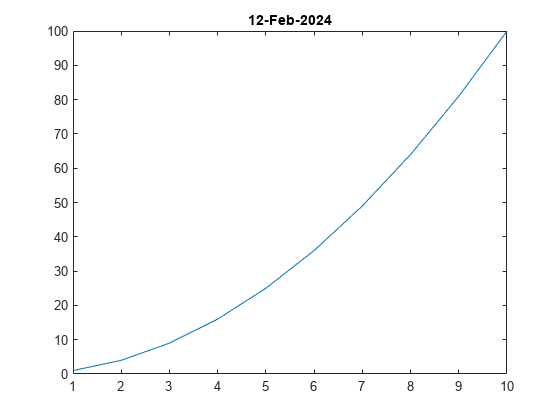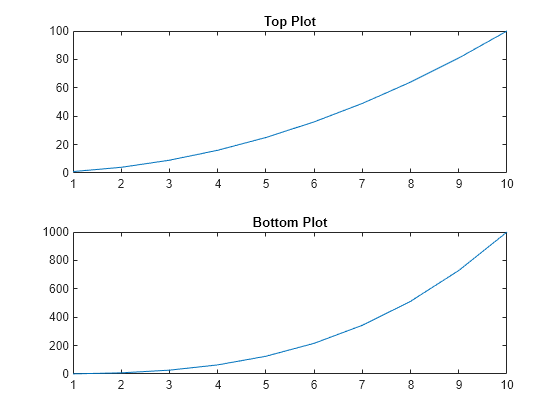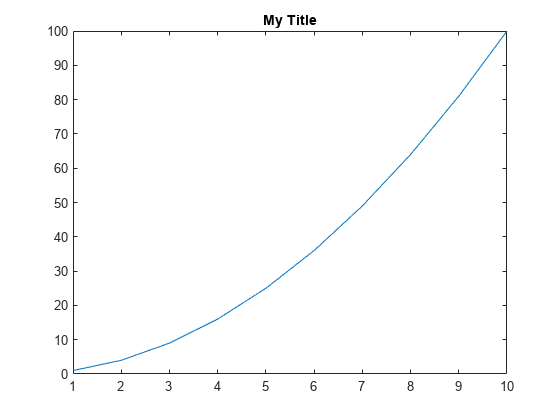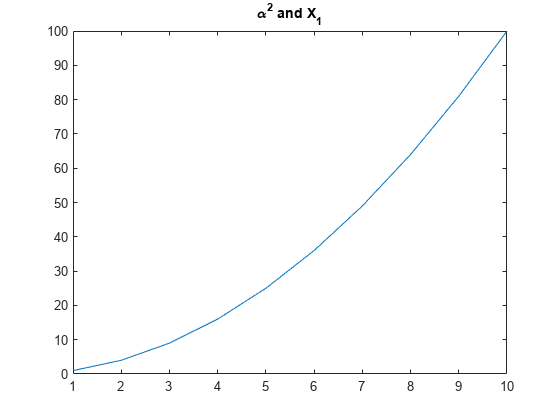title
添加标题
语法
说明
title( 在标题下添加副标题。titletext,subtitletext)
title(___, 使用一个或多个名称-值对组参量修改标题外观。例如,Name,Value)'FontSize',12 将字体大小设置为 12 磅。在所有其他输入参量之后指定名称-值对组参量。并非所有图类型均支持修改标题外观。
示例
在当前坐标区中创建一个图窗并显示标题。
plot((1:10).^2)
title('My Title')
您也可以通过可返回文本的函数来调用 title。例如,date 函数返回包含今日日期的文本。
title(date)

MATLAB® 将 date 的输出设置为坐标区的标题。
创建一个绘图。然后通过调用以两个字符向量作为参量的 title 函数创建一个和一个副标题。使用 'Color' 名称-值对组参量自定义两个文本行的颜色。指定两个返回参量来存储标题和副标题的文本对象。
plot([0 1]) [t,s] = title('Straight Line','Slope = 1, y-Intercept = 0',... 'Color','blue');

将标题的字体大小更改为 16,并将副标题的字体角度更改为 'italic'。
t.FontSize = 16;
s.FontAngle = 'italic';
在标题中包含变量 c 的值。
figure plot((1:10).^2) f = 70; c = (f-32)/1.8; title(['Temperature is ',num2str(c),' C'])

使用颜色修饰符 \color 将其后尾随字符的颜色从先前的颜色更改为新颜色。
plot((1:10).^2) title(['\fontsize{16}black {\color{magenta}magenta '... '\color[rgb]{0 .5 .5}teal \color{red}red} black again'])

创建一个图,并将 t 定义为包含 LaTeX 标记的字符向量。用美元符号 ($) 将标记括起来。然后将 t 传递给 title 函数,并将 Interpreter 属性设置为 'latex'。
x = 0:0.1:10; y = sin(x); dy = cos(x); plot(x,y,x,dy); t = '$sin(x)$ and $\frac{d}{dx}sin(x)$'; title(t,'interpreter','latex')

使用 Name,Value 对组 'Color','m' 将标题的颜色设置为品红色。
figure plot((1:10).^2) title('Case number # 3','Color', 'm')

使用 TeX 标记在标题中包含希腊符号。
t = (0:0.01:0.2); y = exp(-25*t); figure plot(t,y) title('y = \ite^{\lambda t}','Color','b')

'Interpreter' 属性必须为 'tex'(默认值)。
将 Interpreter 属性设置为 'none',以使文本 X_1 按键入原样显示在图窗中,而不会将 1 设置为 X 的下标。
plot((1:10).^2) title('X_1','Interpreter','none')

从 R2019b 开始,您可以使用 tiledlayout 和 nexttile 函数显示分块图。调用 tiledlayout 函数以创建一个 2×1 分块图布局。调用 nexttile 函数以创建坐标区对象 ax1 和 ax2。然后将数据绘制到每个坐标区中。
tiledlayout(2,1) ax1 = nexttile; plot(ax1,(1:10).^2) ax2 = nexttile; plot(ax2,(1:10).^3)

通过将 ax1 和 ax2 传递给 title 函数,为每个坐标区添加标题。
title(ax1,'Top Plot') title(ax2,'Bottom Plot')

在绘图上添加标题,并返回文本对象。
plot((1:10).^2)
t = title('My Title');
将标题的颜色设置为红色。使用圆点表示法设置属性。
t.Color = 'red';
创建一个带有标题的绘图。获取当前坐标区,然后通过将坐标区的 TitleHorizontalAlignment 属性设置为 'left',将标题与图框的左边缘对齐。
plot([0 2],[1 5]) title('Straight Line') ax = gca; ax.TitleHorizontalAlignment = 'left';

通过将坐标区上的 TitleHorizontalAlignment 属性设置为 'center' 使标题居中。
ax.TitleHorizontalAlignment = 'center';
输入参数
标题文本,指定为字符向量、字符向量元胞数组、字符串数组、分类数组或数值。根据您需要的文本外观指定一个值。下表列出了最常见的情况。
| 文本外观 | 值的描述 | 示例 |
|---|---|---|
| 一行文本 | 字符向量或字符串标量。 | txt = 'My Text'txt = "My Text" |
| 多行文本 | 字符向量元胞数组或字符串数组。 | txt = {'First line','Second line'};txt = ["First line", "Second line"]; |
| 包含数值变量的文本 | 包含已转换为 char 数组的数值的数组。使用 num2str 转换值。 |
x = 42;
txt = ['The value is ',num2str(x)]; |
| 包含特殊字符(例如希腊字母或数学符号)的文本 | 包含 TeX 标记的数组。有关支持的标记的列表,请参阅 Interpreter 属性。 |
txt = 'x ranges from 0 to 2\pi' |
注意
default、factory和remove是保留字,当作为标准字符引用时不显示在文本中。要在文本中单独显示这些单词中的任意单词,需在该单词之前放置反斜杠,例如'\default'或'\remove'。如果将此属性指定为分类数组,MATLAB® 将使用数组中的值,而不是类别。
如果您指定仅包含数值的文本,此数值将会使用
sprintf('%g',value)转换。例如,12345678显示为1.23457e+07。
副标题文本,指定为字符向量、字符向量元胞数组、字符串数组、分类数组或数值。根据您需要的文本外观指定一个值。下表列出了最常见的情况。
| 文本外观 | 值的描述 | 示例 |
|---|---|---|
| 一行文本 | 字符向量或字符串标量。 | txt = 'My Text'txt = "My Text" |
| 多行文本 | 字符向量元胞数组或字符串数组。 | txt = {'First line','Second line'};txt = ["First line", "Second line"]; |
| 包含数值变量的文本 | 包含已转换为 char 数组的数值的数组。使用 num2str 转换值。 |
x = 42;
txt = ['The value is ',num2str(x)]; |
| 包含特殊字符(例如希腊字母或数学符号)的文本 | 包含 TeX 标记的数组。有关支持的标记的列表,请参阅 Interpreter 属性。 |
txt = 'x ranges from 0 to 2\pi' |
注意
default、factory和remove是保留字,当作为标准字符引用时不显示在文本中。要在文本中单独显示这些单词中的任意单词,需在该单词之前放置反斜杠,例如'\default'或'\remove'。如果将此属性指定为分类数组,MATLAB 将使用数组中的值,而不是类别。
如果您指定仅包含数值的文本,此数值将会使用
sprintf('%g',value)转换。例如,12345678显示为1.23457e+07。
要添加标题的目标对象,指定为以下项之一:
任何类型的坐标区:
Axes、PolarAxes或GeographicAxes对象。任何类型的图例:
Legend或BubbleLegend对象。TiledChartLayout对象。具有
Title属性的独立可视化。例如,您可以向HeatmapChart对象添加标题。由上述列表中的图形对象组成的数组。这些对象必须属于同一类。要确定类,请使用
class函数。
如果不为标题指定目标,则 title 函数会将标题添加到由 gca 命令返回的图形对象。
注意
有些图不支持修改标题外观(例如颜色),或以输出参量形式返回文本对象。
名称-值参数
以 Name1=Value1,...,NameN=ValueN 的形式指定可选参量对组,其中 Name 是参量名称,Value 是对应的值。名称-值参量必须出现在其他参量之后,但对各个参量对组的顺序没有要求。
在 R2021a 之前,使用逗号分隔每个名称和值,并用引号将 Name 引起来。
示例: 'Color','red','FontSize',14 将添加一个红色、14 磅字体的标题。
除了以下属性之外,还可以使用 Name,Value 对组参量指定其他文本对象属性。请参阅 Text 属性。
字体大小,指定为大于 0 的标量值(以磅为单位)。一磅等于 1/72 英寸。要更改字体单位,请使用 FontUnits 属性。
如果将标题或副标题添加到坐标区对象,则坐标区的字体大小属性也会影响标题和副标题的字体大小。标题和副标题字体大小是坐标区字体大小与一个缩放因子的乘积。坐标区的 FontSize 属性包含坐标区字体大小。坐标区的 TitleFontSizeMultiplier 属性包含缩放因子。默认情况下,坐标区的字体大小为 10 磅,缩放因子为 1.1,因此标题和副标题的字体大小各为 11 磅。
数据类型: single | double | int8 | int16 | int32 | int64 | uint8 | uint16 | uint32 | uint64
文本字符的粗细,指定为下列值之一:
'normal'- 由特定字体定义的普通粗细'bold'- 字符轮廓比普通粗
MATLAB 使用 FontWeight 属性从系统提供的字体中选择一种字体。并非所有字体都有加粗字体。因此,指定加粗字体仍可能产生常规字体。
相关联坐标区的 TitleFontWeight 属性影响标题的 FontWeight 值。同样,相关联坐标区的 SubtitleFontWeight 属性影响副标题的 FontWeight 值。
注意
'light' 和 'demi' 字体粗细值已被移除。请改用 'normal'。
字体名称,指定为支持的字体名称或 "FixedWidth"。要正确显示和打印文本,您必须选择系统支持的字体。默认字体取决于您的操作系统和区域设置。
要使用在任何区域设置中都有较好显示效果的等宽字体,请使用 "FixedWidth"。等宽字体依赖于根 FixedWidthFontName 属性。设置根 FixedWidthFontName 属性会导致立即更新显示方式以使用新字体。
文本颜色,指定为 RGB 三元组、十六进制颜色代码、颜色名称或短名称。默认值 [0 0 0] 对应于黑色。
对于自定义颜色,请指定 RGB 三元组或十六进制颜色代码。
RGB 三元组是包含三个元素的行向量,其元素分别指定颜色中红、绿、蓝分量的强度。强度值必须位于
[0,1]范围内,例如[0.4 0.6 0.7]。十六进制颜色代码是字符串标量或字符向量,以井号 (
#) 开头,后跟三个或六个十六进制数字,范围可以是0到F。这些值不区分大小写。因此,颜色代码"#FF8800"与"#ff8800"、"#F80"与"#f80"是等效的。
此外,还可以按名称指定一些常见的颜色。下表列出了一些命名颜色选项、其等效 RGB 三元组及十六进制颜色代码。
| 颜色名称 | 短名称 | RGB 三元组 | 十六进制颜色代码 | 外观 |
|---|---|---|---|---|
"red" | "r" | [1 0 0] | "#FF0000" |
|
"green" | "g" | [0 1 0] | "#00FF00" |
|
"blue" | "b" | [0 0 1] | "#0000FF" |
|
"cyan" | "c" | [0 1 1] | "#00FFFF" |
|
"magenta" | "m" | [1 0 1] | "#FF00FF" |
|
"yellow" | "y" | [1 1 0] | "#FFFF00" |
|
"black" | "k" | [0 0 0] | "#000000" |
|
"white" | "w" | [1 1 1] | "#FFFFFF" |
|
"none" | 不适用 | 不适用 | 不适用 | 无颜色 |
下表列出了浅色和深色主题中绘图的默认调色板。
| 调色板 | 调色板颜色 |
|---|---|
在 R2025a 之前的版本中: 大多数绘图默认使用这些颜色。 |
|
|
|
您可以使用 orderedcolors 和 rgb2hex 函数获取这些调色板的 RGB 三元组和十六进制颜色代码。例如,获取 "gem" 调色板的 RGB 三元组并将其转换为十六进制颜色代码。
RGB = orderedcolors("gem");
H = rgb2hex(RGB);在 R2023b 之前的版本中: 使用 RGB = get(groot,"FactoryAxesColorOrder") 获取 RGB 三元组。
在 R2024a 之前的版本中: 使用 H = compose("#%02X%02X%02X",round(RGB*255)) 获取十六进制颜色代码。
示例: 'blue'
示例: [0 0 1]
示例: '#0000FF'
文本解释器,指定为下列值之一:
'tex'- 使用 TeX 标记子集解释字符。'latex'- 使用 LaTeX 标记解释字符。'none'- 显示字面字符。
TeX 标记
默认情况下,MATLAB 支持一部分 TeX 标记。使用 TeX 标记可添加下标和上标,修改字体类型和颜色,并在文本中包括特殊字符。
修饰符会一直作用到文本结尾,但上标和下标除外,因为它们仅修饰下一个字符或花括号中的字符。当您将解释器设置为 "tex" 时,支持的修饰符如下所示。
| 修饰符 | 描述 | 示例 |
|---|---|---|
^{ } | 上标 | "text^{superscript}" |
_{ } | 下标 | "text_{subscript}" |
\bf | 粗体 | "\bf text" |
\it | 斜体 | "\it text" |
\sl | 伪斜体(通常与斜体相同) | "\sl text" |
\rm | 常规字体 | "\rm text" |
\fontname{ | 字体名称 - 将 | "\fontname{Courier} text" |
\fontsize{ | 字体大小 - 将 | "\fontsize{15} text" |
\color{ | 字体颜色 - 将 red、green、yellow、magenta、blue、black、white、gray、darkGreen、orange 或 lightBlue。 | "\color{magenta} text" |
\color[rgb]{specifier} | 自定义字体颜色 - 将 | "\color[rgb]{0,0.5,0.5} text" |
下表列出了 "tex" 解释器所支持的特殊字符。
| 字符序列 | 符号 | 字符序列 | 符号 | 字符序列 | 符号 |
|---|---|---|---|---|---|
| α |
| υ |
| ~ |
| ∠ |
| ϕ |
| ≤ |
|
|
| χ |
| ∞ |
| β |
| ψ |
| ♣ |
| γ |
| ω |
| ♦ |
| δ |
| Γ |
| ♥ |
| ϵ |
| Δ |
| ♠ |
| ζ |
| Θ |
| ↔ |
| η |
| Λ |
| ← |
| θ |
| Ξ |
| ⇐ |
| ϑ |
| Π |
| ↑ |
| ι |
| Σ |
| → |
| κ |
| ϒ |
| ⇒ |
| λ |
| Φ |
| ↓ |
| µ |
| Ψ |
| º |
| ν |
| Ω |
| ± |
| ξ |
| ∀ |
| ≥ |
| π |
| ∃ |
| ∝ |
| ρ |
| ∍ |
| ∂ |
| σ |
| ≅ |
| • |
| ς |
| ≈ |
| ÷ |
| τ |
| ℜ |
| ≠ |
| ≡ |
| ⊕ |
| ℵ |
| ℑ |
| ∪ |
| ℘ |
| ⊗ |
| ⊆ |
| ∅ |
| ∩ |
| ∈ |
| ⊇ |
| ⊃ |
| ⌈ |
| ⊂ |
| ∫ |
| · |
| ο |
| ⌋ |
| ¬ |
| ∇ |
| ⌊ |
| x |
| ... |
| ⊥ |
| √ |
| ´ |
| ∧ |
| ϖ |
| ∅ |
| ⌉ |
| 〉 |
| | |
| ∨ |
| 〈 |
| © |
LaTeX 标记
要使用 LaTeX 标记,请将解释器设置为 "latex"。对于行内模式,用单美元符号 ($) 将标记括起来。对于显示模式,用双美元符号 ($$) 将标记括起来。
| LaTeX 模式 | 示例 | 结果 |
|---|---|---|
| 行内 |
"$\int_1^{20} x^2 dx$" |
|
| 显示 |
"$$\int_1^{20} x^2 dx$$" |
|
显示的文本将使用默认的 LaTeX 字体样式。FontName、FontWeight 和 FontAngle 属性不起任何作用。要更改字体样式,请使用 LaTeX 标记。
用于 LaTeX 解释器的文本最多可以包含 1200 个字符。对于多行文本,请在此数量的基础上每行减少约 10 个字符。
MATLAB 支持大多数标准 LaTeX 数学模式命令。有关详细信息,请参阅支持的 LaTeX 命令。有关使用 TeX 和 LaTeX 的示例,请参阅图文本中的希腊字母和特殊字符。
输出参量
用于副标题的对象,以文本对象形式返回。创建副标题后,使用此文本对象修改副标题的属性。有关文本对象属性的列表,请参阅 Text 属性。您还可以通过坐标区对象的 Subtitle 属性访问副标题。
提示
默认情况下,
Interactions属性包含editInteraction,因此可以通过点击文本来编辑文本。要禁用此交互,请将文本对象的Interactions属性设置为[]。
版本历史记录
在 R2006a 之前推出
MATLAB Command
You clicked a link that corresponds to this MATLAB command:
Run the command by entering it in the MATLAB Command Window. Web browsers do not support MATLAB commands.
选择网站
选择网站以获取翻译的可用内容,以及查看当地活动和优惠。根据您的位置,我们建议您选择:。
您也可以从以下列表中选择网站:
如何获得最佳网站性能
选择中国网站(中文或英文)以获得最佳网站性能。其他 MathWorks 国家/地区网站并未针对您所在位置的访问进行优化。
美洲
- América Latina (Español)
- Canada (English)
- United States (English)
欧洲
- Belgium (English)
- Denmark (English)
- Deutschland (Deutsch)
- España (Español)
- Finland (English)
- France (Français)
- Ireland (English)
- Italia (Italiano)
- Luxembourg (English)
- Netherlands (English)
- Norway (English)
- Österreich (Deutsch)
- Portugal (English)
- Sweden (English)
- Switzerland
- United Kingdom (English)













